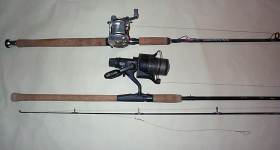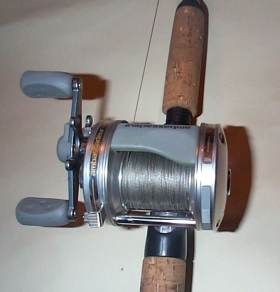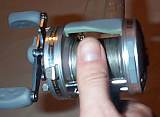|
|
| |
I assume that there are plenty of people out there who, like me, have never ventured into this increasingly popular aspect of our sport. So it seemed quite a good idea to give a blow by blow account of how I made my first faltering steps into this brave new world. I will not be attempting to baffle people with clever talk – indeed, as I mentioned earlier, I wouldn’t know how too. What I will do, however, is give an honest appraisal of how I fared. So in advance, I make no apologies for my lack of knowledge on the subject. In fact I hope my total lack of understanding will be what makes the articles interesting.
Please feel free to comment……The Forum is at your disposal!
Part 2 – Choosing The Correct Gear
After reading through numerous articles and taking a lot of advice I eventually decided on what tackle I would require to lure fish effectively. Basically, other than my landing net and a large fixed spool reel none of my existing pike gear would suffice and I would need to purchase a substantial amount of new equipment.
Rods
My current pike rods are my pride and joy. They are old, battered and totally unfashionable but I love them. Made by Tri-Cast the pair of 12ft, 3lb test curve ‘Sceptres’ was one of my better purchases. I have had them over a decade and have been fortunate enough to land some good pike, carp and catfish on them, the through-action of them making playing fish a joy (I would love a third one – anyone out there got one for sale?). Unfortunately a rod of this size is just far too heavy and cumbersome to use on a boat so I needed to get hold of a purpose built lure rod.
Although it seemed preferable to use a multiplier my budget would not run to this so I needed to get a rod which was capable of matching to a fixed spool reel. A basic way of deciphering which reel you are meant to use on a lure rod is that one that is designed to be used with a multiplier has a small ‘trigger’ on the underside (opposite side to the rings).
|
|
| |
So I knew what I wanted……as I would be holding and casting the rod all day it would need to be short, slim and light, but would still need some real backbone should a big girl need to be dragged away from an anchor rope (I’ve never lost one on a rope again!). There also seemed to be another category that I had to take into account and this was based on casting weight. Just as fly rods are designed to cast lines of various weights so spinning rods are designed to cast lures of differing weights.
As mentioned earlier, as I was gearing up to catch big fish the majority of the lures I would be using would be relatively large so I decided to choose one rated at 50 – 100 grams which is on the heavier end of the scale. When all this had been considered it came down to a choice of just two. The ‘Thunderstick’ by Normark and the ‘Shimano Technium Spinning Rod’. In the end I decided to plump for the Shimano for several reasons. It was made from a slimmer blank but seemed to have more reserve in the butt section, its finish was superior, it was lighter and perhaps most important of all – it was on special offer for under £ 50!
All the information I had read seemed to point to the fact that I would be foolish to be fishing without the option of jerkbaiting. Basically, from what I could gather this involved dragging a huge lump of wood or rubber through the water and unlike crankbaits (see I know all the correct words now!) they have very little action built into them. This means that all the action must be imparted into the lure using the rod.
For this reason another purpose built rod must be used. After making a few enquiries I was lucky enough to get offered a jerkbait rod that had been given to a friend as an unwanted gift. It was offered at half its marked value so I really didn’t go into any detail as to its suitability. After all I had been lead to believe that a jerkbait rod was little more than a stepped-down sea fishing boat rod. For the record £ 30 secured me a 6ft one piece ‘Toothy Critter’ Masterline Jerkbait rod – if its good enough for the legendary John Wilson, its good enough for me!
Reels
Although I intended to use my old Shimano 4500 fixed spool reel with the lure (crankbait) rod I now needed a multiplier to go with the jerkbait set up – this was all getting a bit expensive! The choice of multiplier was quite simple enough.
There appears to be a few cheap ones on the market but I’m a great believer in taking advice, after all there aren’t many adverts around telling you how crap their goods are. According to the literature every tackle manufacturer makes the best reels on the market. Well, to cut a long story short every lure angler I spoke to recommended the ABU Ambassadeur 6501 (left hand wind). This reel retailed at around £ 130 but after a few phone calls I managed to procure one from Derby Angling Centre for under £ 70.
|
|
| |
Braid Versus Mono
It soon became apparent that it was not a question of whether I should use braid or mono, but rather which braid should I use ?
The benefits of braid were so overwhelming that for lure fishing – especially with large lures, mono was a non-starter. Having never been a big fan of braid in conventional angling (its non-stretch properties frightened me!) I started to look at my options. I already knew that it had a diameter far below the equivalent breaking strength of mono so I guessed about 30lb’s would be about right. Once again it appeared I was wrong. All the advice I received was that I should at least DOUBLE my estimation. It appeared that the new high tech braids in the region of 65 – 100lbs were of the same diameter as 15lb mono.
|
|
| |
Eventually I settled for ‘Power Pro Braided line’ imported from America in 65lb and 100lb test. Although this braid was slightly more expensive than most, I was assured that it was soft enough to be almost tangle free and had a similar diameter to other braids of half its breaking strain.
Another ‘must’ for the braid was that when jerkbaiting all the action in the bait would be produced by movements of the rod tip. The braid meant that every little tweak of the rod either fast or slow would impart the same action into the lure.
I was also reliably informed that this braid would pay for itself several times over as the sheer strength of the braid meant that if I did snag up then I wouldn’t loose my lure. I would simply pull the offending snag in to the boat or I would straighten the trebles, thus retrieving my lure and saving a small fortune over the next couple of seasons.
Okay, so now I have two complete set ups as listed below:
Crankbait Outfit
Rod : Shimano Technium Spinning – 270XH. Casting weight 50-100g
Reel : Shimano 4500 Baitrunner (Fixed spool)
Braid :65lb Power pro
Jerkbait Outfit
Rod :Masterline ‘Toothy Critter’ 6ft. Casting weight 28-110g
Reel : ABU Ambassadeur 6501- C3 (multiplier)
Braid:100lb Power Pro
Next would be the fun bit – choosing some lures. Although I have never been into lure fishing I have always had a sneaky look at them whenever I’m in a tackle shop. But I was about to have my eyes opened dramatically. When I saw what were the current ‘vogue’ lures I began to get the uneasy feeling that the whole thing was a scam again. I mean can lumps of jelly and bits of wood sawn off the end of a broom handle REALLY catch big fish ?
Lured into Lure Fishing – Part 3 – Choosing my lures














